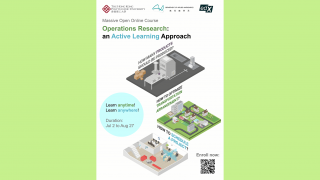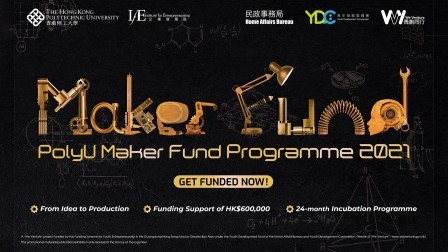Neon signs witness the history of Hong Kong, says Brian Kwok from PolyU’s School of Design
Hong Kong has been renowned for its night scenery for many years, and one of the reasons is undoubtedly the neon signs that have lighted up the city in the evening. Brian Kwok, Associate Professor at the School of Design of PolyU, who is particularly interested in the neon signs, will share more about his research project on this subject.
Brian had his training in visual communication design in the United States, after which he worked in various multimedia design firms and advertising agencies. He then pursued further studies and obtained an MA degree in Design from PolyU and an MA degree in Visual Culture Studies and an MPhil degree in Communication from The Chinese University of Hong Kong. Brian started his teaching career at PolyU in 2006 and he is now the leader of the BA (Hons) in Communication Design programme and the Information Design Lab.
Neon signs tell the history of Hong Kong
Brian started the research project on Hong Kong neon signs in 2016. One of the team’s critical tasks was to photo-document the neon signs that could still be found in different districts in Hong Kong. While neon light manufacturing is a sunset industry in Hong Kong, the team managed to interview some neon masters and visited the neon light manufactories.

A project supported by the Arts Go Digital Platform Scheme of the Hong Kong Arts Development Council, “The Archive of Hand-Painted Neon Sign Artworks” presents Hong Kong’s vernacular visual culture, aesthetics and societal development from the 1950s to 1970s.
“Surprisingly, we were lucky to discover about 1,000 original neon sign artworks in one of the local neon light manufactories! These artworks were all hand-painted and are still in good condition, and more importantly, they have never been seen by the public,” Brian said.
The owner of the neon light manufactory was very supportive and donated all the artworks to the School of Design for educational and research purposes. Subsequently, these artworks have been documented, categorised and digitised in a neon sign artwork archive.

Brian Kwok received the “2019 Hong Kong Book Prize” from Radio Television Hong Kong and the Hong Kong Publishing Federation with his book "Fading of Hong Kong neon lights – The archive of Hong Kong visual culture" (《霓虹黯色――香港街道視覺文化記錄》).
The fabulous thing about this batch of neon sign artworks lies in their quantity, originality and completeness. These artworks have more than 60 years of history, and are therefore very rare and precious. Each piece of these artworks was drawn by hand. That is to say, the neon artists visualised the clients’ ideas and concepts all by hand, unlike using a computer nowadays.
Brian said, “These artworks are an invaluable reference for studying Hong Kong's design and visual arts history. Besides, these artworks can also give a peek into Hong Kong's social, economic and cultural development in the past. Thus, my attempt is to explore more interesting Hong Kong stories and unique local visual culture from these artworks, exploring and examining the interrelationship between the aesthetics of neon signs and the development of local industries.”
Design can stem from different disciplines
Having joined the School of Design more than 15 years ago, Brian feels grateful about collaborating and conducting research with different fellow colleagues. “My colleagues come from different design disciplines, for example, computer science, visual culture studies and commerce. Some of them are architects and urban planners, while some are experts in behavioural psychology. Different academic backgrounds have broadened my horizons of design knowledge,” he stated.
Talking about his design students, Brian said the way they absorb knowledge from the Internet and social media is fascinating. Thanks to new technologies and mobile devices, design students nowadays can obtain global design knowledge, anytime and anywhere. The resources are unlimited as long as they are still thirsty for knowledge. He believes that this helps create a more favourable learning environment and provides greater possibilities for students to come up with innovative designs.
Designers can help make a better world
A good design is one that can be applied to daily life and brings benefits to people. This is demonstrated in one of the projects supervised by Brian. “We noticed that elderly people sometimes encounter problems that arise from the design of products, especially the packing and storage of medicine,” Brian said. The team reviewed existing medicine packing and the needs of the elderly through a human-centred design approach and came up with a medicine holder designed in the form of a pen. Highly convenient and portable, the new design facilitates the storing and stacking of capsules or circular pills, enhancing the medication administration experience of the elderly. The stylish design also helps to maintain the dignity of the users.

An innovative health communication design, “Readyset” enhances the medication administration experience of elderly.
This innovative health communication design titled “Readyset” won a Bronze ADC Cube Award in the international design competition, The One Club for Creativity, in 2019 for Brian’s Communication Design students, namely Lok Ngai Lego Lam, Ping Ting Lee, Man Yin Chan and Rachel Yin.

“Designers should always see the world from new perspectives.”
“As a designer or design educator, we should discover new things in our daily lives. It is therefore necessary for us to keep absorbing different knowledge, such as history, culture, economy, society and technology,” Brian remarked. “We should not be satisfied with the status quo; we have to be sensitive to things around us and always see the world from new perspectives, with the aim to make a better world with good design.”





